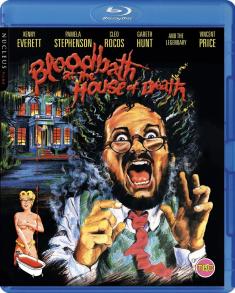Denon AVR-988 AV Receiver
Overview -This article has been abridged and updated from an original review on HDD's sister-site www.AVRev.com
IntroductionThe Denon AVR-988 that I am reviewing falls somewhere in the mid to upper end of Denon’s A/V receiver lineup, with a retail price of $1,199. The list of features the Denon offers is simply staggering. I'll highlight the ones that I think will interest most readers.
Its power is rated at 110 watts into eight ohms, with all seven channels driven. If you already have amplifiers, then you can use it as a stand-alone processor with the pre-amp outputs. The rear panel was well thought-out, although nearly all the real estate was occupied to allow for practically every type of input imaginable. I cannot imagine possibly running out, considering it offers eight sets of analog two-channel inputs, a 7.1 input, three coax and three optical digital inputs, three component video, two HDMI 1.3, an XM input and a bunch of composite and S-video inputs as well. Just for good measure, there are another optical digital, two-channel analog and composite and S-video inputs on the front of the unit, should you need to connect a video camera or similar item. Like I said, if you run out of inputs with the AVR-988, chances are you have too many components and are more than likely going to start a fire due to the electrical draw.
In terms of surround processing power, you will not run out of that, either. The AVR-988 can process Dolby Digital signals with algorithms, including Dolby Digital EX, Pro-LogicIIx Cinema and Music, Digital + and True HD. It can process DTS signals via DTS Surround, DTS Pro-LogicIIx Cinema and Music, Neo:6, ES Matrix6.1, ES Discrete 6.1, DTS 24/96, DTS-HD and DTS-HD Master. If this isn’t enough, the Denon also provides 10 additional DSP modes to make your living room sound like a jazz club, a stadium or whatever else you can imagine. There are a few acronyms that are missing, however, namely THX, HDCD, MP3 and WMA. It isn’t THX-certified and it will not decode HDCDs, MP3 or WMA (Windows Media Audio) files, which may be important if you have a large library of MP3s.
Speaking of MP3s, the AVR-988 also has a host of accessories that make integrating your iPod a snap, including the D-Dock, which allows your Denon remote to control the iPod and also displays the files meta-data on the front of the receiver. There is also an XM radio antenna, which can be added for easy access to non-terrestrial radio, albeit for a small monthly fee.
From a design perspective, the Denon is understated and minimalist. It comes in black and has a large glass display in the center and one large knob on each side. The left knob is multi-functional and can be used to select source, tuning, zone and video output, which lets you keep listening to your audio input while selecting a video source on the fly. I’m using it right now to listen to my CD player and watch TV at the same time. This is nice, since I can configure it without having to go into the receiver’s menu, which is very convenient. In the center under the display is a large flip-down panel that hides the aforementioned extra inputs, as well as several menu item buttons that are accessed only on occasion, or if you happen to lose your remote.
Speaking of remotes, the one supplied by Denon is quite unique. It has all the most common buttons you would expect, neatly arranged and easy to discern, but flip it over and there is an unexpected surprise. A flip-open cover reveals a host of additional buttons that one occasionally needs. I thought this was a great idea and really came in handy during the set-up process. The buttons on the main side are thoughtfully laid out and well contoured to be easily identified by touch. For example, the largest buttons are concave and convex, indicating volume down and up respectively, and are placed right where my thumb lands when holding the remote. This is one of the most ergonomic remotes I’ve used.
Set-upOnce the Denon was out of the box, I did what comes naturally and started plugging my cables in. Luckily, the rear panel is well labeled, so there is no need to consult the instruction manual. For my system, I am using both HDMI inputs, one for my DirecTV tuner and the other for my Playstation 3. The HDMI output connects to my Sony 60-inch SXRD rear-projection display. I use the component video input for my Esoteric DV-50 universal player and both digital and analog inputs for audio. I already have a Sangean tuner, so I decided to feed that into the receiver instead of letting the Denon do the tuning, primarily because my tuner is already programmed with my favorite stations, but also because the Denon will not tune HD radio sources as my Sangean will.
I connected my Boston Acoustic 5.1 speaker system to the receiver’s speaker terminals, which are well-placed at the bottom of the rear panel, although I would prefer to have a little more space between them. I used banana terminals, so I didn’t have to worry about all the twisting, which would be required with bare wires. However, even if I had used bare wires, the plastic-covered knobs are large enough to make it a painless process.
With all the connections done, I finally picked up the user’s manual to help me figure out how to configure the AVR-988 to behave the way I wanted. To be blunt, the menu structure is not most intuitive that I’ve ever used. However, after a few tries, I got the hang of it and configured all of my inputs and outputs. I noticed that there is an unexpectedly long five-second delay between the time I press the menu button and when my display shows the menu options. I assume this has something to do with HDMI and all its complexities, but I never did get used to the long lag time. With those two small gripes out of the way, the Denon is extremely flexible. The switching allows you to mix and match inputs any way you want and you can also set default sound processing modes to inputs, so each device sounds the way you want.
Next, I needed to set my speaker levels and distances. Luckily for me, this was all going to be handled automatically by the Audyssey room correction and set-up software. It’s a very simple process to install the supplied microphone to the front of the receiver and mounting it so that it’s at ear level on a moveable stand of some sort; I used a camera tri-pod. The first measurement is made at the main listening location to determine how many speakers you have, the polarity and frequency response of each, and also optimizes the gain level of each channel. You need to be careful to keep external sounds to an absolute minimum, so the results are not compromised. During the test, a series of sonar-type sounds are emitted from each speaker – and it can get loud, so don’t try to do it while your family is asleep. The test lasts maybe 30 seconds. Then you are prompted to move the microphone to another location and repeat. I ran the test eight times from different locations in my room, which is the maximum allowed. The software then does some number crunching and your set-up is complete. The software is able to accomplish in about 10 minutes what use to take closer to 30 when doing it manually with an SPL meter and a test disk, and that is without room correction. The corrected settings can be defeated, so you can compare just how the sound experience has changed. I will say that it was not subtle in my experience. Sounds were much more focused in space and each channel sounded nearly identical. I say this because I had become accustomed to one surround always having a bit more bass response than the other, due to the fact that one wall is closer than the other. The room correction did a wonderful job of balancing this. Just to make sure it wasn’t my mind playing tricks on me, I purposely flipped surround channels to hear the same information from each speaker. Problem solved. Room correction is here to stay and I can say that, after this experience, I will never own a processor of any sort that does not include it.
Music and MoviesI began my review, as I always do, listening in two-channel mode. Being something of a two-channel snob, I was interested to hear how the Burr-Brown DACs in the receiver stacked up to the DACs in my Esoteric DV-50, so I fed the Denon the digital and analog outputs, so I could easily flip back and forth between them.
I started out with Ryan Adams’ “Rosebud” from the double-disc Cold Roses album (Lost Highway). The song consists primarily of his voice, an acoustic guitar, a stand-up bass and little else. Adams’ voice was clear and rock solid in the middle of the soundstage and floated a bit in front of the rest of the instruments. There was a nice depth to the rest of the soundstage, too. Guitar picks had snap and the strings resonated with a very natural decay. The bass was deep and detailed, with a nice weight. The Denon produced clear and detailed music that I listened to for hours without fatigue. I have to say, I was pretty impressed.
Next, I played Alice in Chains’ “Rotten Apple” from the Jar of Flies album (Columbia). Again, I noticed weight and power in the bass department. Resolution was excellent, as it was easy to separate Layne Staley and Jerry Cantrell’s voices, even though they are right on top of each other through the entire song. “Don’t Follow,” from the same disc, starts with an acoustic guitar and a harmonica. The Denon did a great job of fleshing out all the natural textures from the harmonica, while also providing detail and clarity. The musicians occupied their own unique space in three dimensions. The stage had excellent width and depth. When the kick drum came in midway through the song, it did so with authority and slam. Even when really pushing the system hard, I never noticed the sound getting compressed or the treble getting harsh.The Denon’s amplifier section was always in complete control of the speakers and, along with the very high-quality DACs, it did a wonderful job of making music. Yes, there were some noticeable differences between the Denon and my Esoteric, but considering the fact that the DV-50 cost nearly five times what the Denon does, the differences were smaller than I anticipated.
Now I had to see if this machine was equally capable of bringing movies to life the way it had music. I started off with the latest Blu-Ray installment from my favorite British secret agent 007 in Casino Royale (Sony Pictures Home Entertainment). I selected DTS Neo:6 Cinema, which sounded best to me and let it rip. In typical Bond fashion, the opening sequence is packed full of action. It begins with Bond pursuing a villain through a crowded city in Madagascar. During the chase, the soundscape is littered with a wide variety of explosions and music to add to the excitement. Each gunshot produces a thump in the chest that can be felt as well as heard. Gas tanks from a welding rig explode after falling several floors with a roar, which slowly comes toward the audience, eventually curling around behind and fully enveloping you. The auditory fireworks continue after a shootout begins in an embassy where legions of Kalashnikovs fire in unison to try to gun down Bond. Each rifle is clear and distinguishable as they surround the audience and bullets zing through the room. Being a car guy, I knew that one of the true stars of this film is an Aston Martin DBS and I could not wait to see and hear it. I was not disappointed as I heard the throaty V12 scream down the road with Formula one style shifts. I was, however, heartbroken to see this gorgeous car destroyed as it flipped and rolled later in the film. The picture quality is absolutely breathtaking and I noticed no difference between running the HDMI cable directly to my monitor and letting the Denon perform the HDMI switching.
Next up on my playlist was standard DVD of Transformers (Paramount Home Entertainment). While it wasn’t quite the same as my true HD sources, it looked damn good. Like Casino Royale, the opening sequence of Transformers is pure adrenaline. It begins with Blackout, a transformer disguised as an MH-53M Pave Low IV helicopter, flying towards a military base in Qatar. The helicopter blades produce a low-frequency “whump-whump-whump-whump,” which will absolutely pressurize a room, assuming you have enough subwoofer to do so. It sounds deep, powerful and menacing, just as it is designed to do. After the tail numbers of the chopper come back, the same as one that was previously shot down, you know something is wrong. Upon landing, the helicopter transforms into its native robotic form and proceeds to decimate the airbase. Ultra-low-frequency explosions toss M1 tanks around the base as if they were toys; AC-130 gun ships are also disintegrated before your eyes in spectacular fashion. Do not play this movie at loud volumes, unless your subs are up to the task – consider yourself warned. However, don’t think that this is a one-trick pony, only good at only creating bangs and booms. It also does an excellent job reproducing voices. They are clear and crisp with rich texture. Auditory clues to the environment are also perfectly positioned and convincing. I can’t think of a single fault with the playback performance of the AVR-988. It is beautiful to listen to as it is to use for watching video.
The DownsideWith the wonderful performance of the AVR-988, there are a few ergonomic issues that I would like to see improved. First of all, I think the menu structure needs to be updated to be more intuitive and requires less back and forth screen changes. I would also like to have the option to display the menu over the current video, so I could see changes I made to the video settings in real time. Second, I would like to see the remote control get some backlighting for the buttons. Even though the most common buttons are discernable by touch alone, the others are not. I would note that the folks at Denon made a half-hearted attempt by surrounding the buttons on the remote with glow-in-the-dark material, but what good is that when you are sitting in a dark room watching a movie? In a few minutes, the glow material no longer glows and you are fumbling with buttons again.
ConclusionThe Denon can honestly do it all, and do it at a very high level. It sounds great and has boatloads of power, which can get you into serious trouble with the neighbors. It has processing power for dozens of surround and DSP modes. It’s a video switcher, processor and scaler all in one, and it never once gave me a problem with my multiple HDMI sources, which was truly a surprise. I am so impressed with this receiver that I truly do not want to give it back. This receiver has single-handedly re-opened my eyes to the fact that performance and convenience are not mutually exclusive. Very, very well done, Denon.












